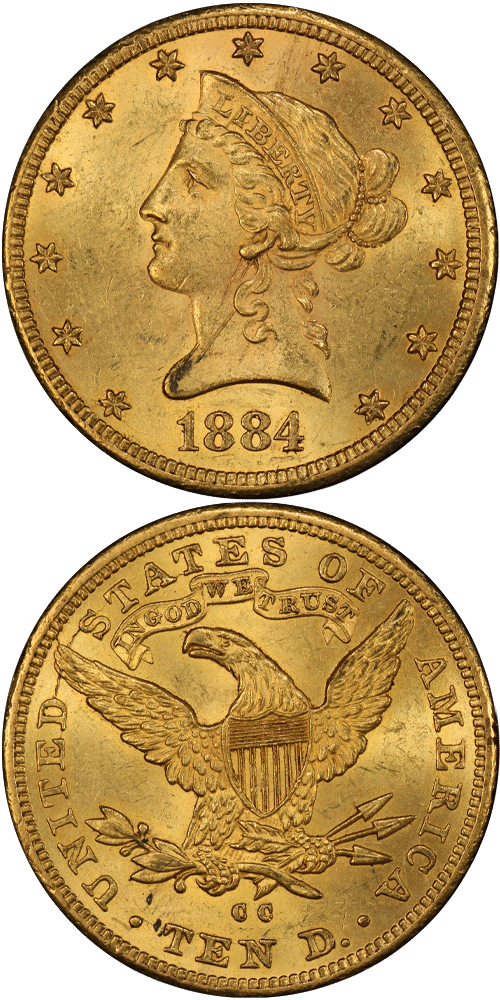1884-CC Liberty Head Eagle
Jeff Ambio: All known 1884-CC Liberty eagles display a curious set of raised die lines, as made, slanting down from right to left on Liberty's neck. The often-quoted explanation for these features is that they are chisel marks deliberately imparted to deface or otherwise "cancel" the obverse die. Another possible explanation, offered in our (Bowers and Merena's) sale of the Harry W. Bass, Jr. Collection, Part IV, lot 749, is that these raised die lines represent heavy die file lines imparted to remove clash marks that were not removed though the finer die polishing process. Either way, these raised lines serve as a readily evident diagnostic of all genuine 1884-CC Liberty eagles. Incidentally, the date on this obverse is large, well centered, and fairly even. The reverse appears to be the same as that used to strike 1883-CC eagles of the Winter 1-A variety, with the mintmark widely spaced, yet even. The first C is above the space between the letters EN in TEN and the second C is over the left serif of the right upright of the letter N.
Rusty Goe: The people living in Carson City in 1884 looked back on the local mint's 15 years in business with a sense of great pride. The two solid years of non-stop coining activity, in 1882 and 1883, only served to boost civic morale.
Rumors from the Rocky Mountain region had attempted to squelch some of this gratification as 1884 began. In January, Denver's Tribune had reported that "Senator [Nathaniel P.] Hill's bill transferring the Mint of Coinage from Carson City, Nev., to Denver should meet with no serious opposition."
However, by the time Mint Director Burchard arrived in Carson City on June 30 to supervise annual settlement, the mint had showed no sign of slowing down. Silver dollars and double eagles once again had accounted for the bulk of the coining department's work. Gold eagles and half eagles consumed about ten percent of the portion of that metal allotted for coinage.
Coiner Dague had stamped out 6,756 eagles before Burchard hit town in June. Dague ran another 3,169 eagles through his press in the second half of 1884. This was the third consecutive year that this denomination's piece-count had been the lowest of all coins struck at the Carson Mint.
The estimated populations of coins from our nation's past at times present curious aspects. Why, for instance, does the survival rate for Carson City eagles in the 1880s lock in somewhere around three percent? There is no logical explanation for this. All we know is that it's true. Mint State survivors provide more mysteries for us. Why do some dates have more and some less? Who knows?
As for the 1884-CC eagle, fewer than ten examples are known in Mint State condition, the Harry W. Bass Jr. specimen, graded MS-63 by PCGS, towering above all others. The Battle Born piece is a prize in itself, and certainly deserves a high ranking in the condition census.
Q. David Bowers: From a mintage of 9,925 1884-CC eagles, Rusty Goe estimates 295 to 345 with 10 to 12 in Mint State. Again, my estimate is on the conservative side with 110 to 150 overall and four to seven Mint State. Extremely Fine is the usually encountered grade, but higher and lower pieces are seen as well. Very scarce overall.
The example to the left was sold by Stack's Bowers Galleries in the August 2021 Chicago ANA Auction, where it realized $132,000.






